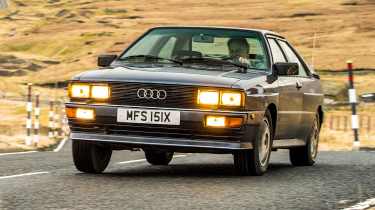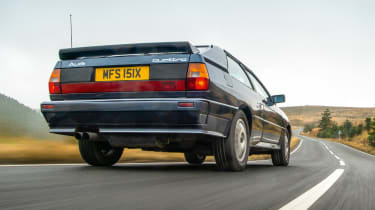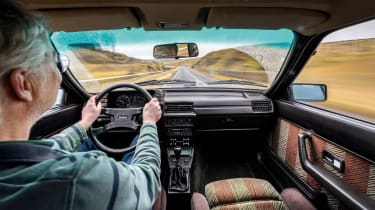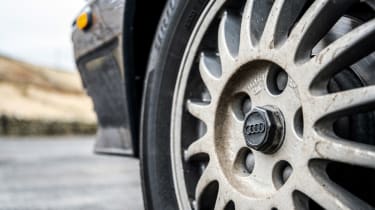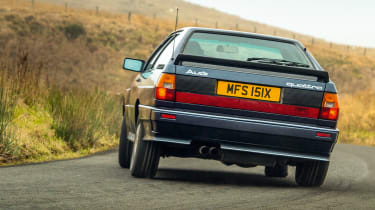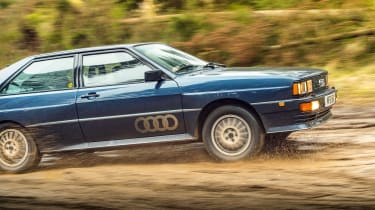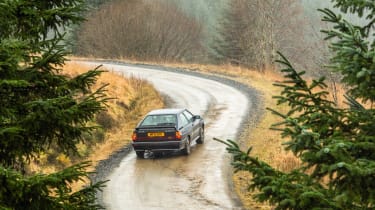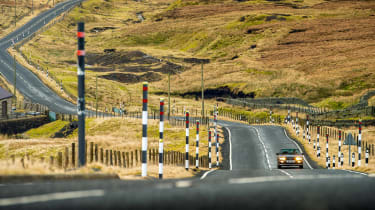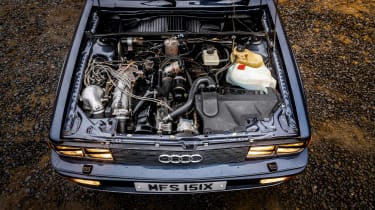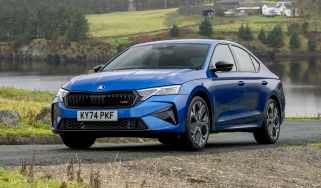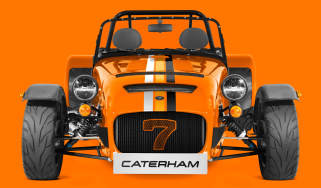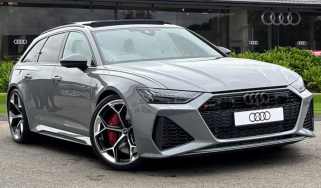Audi Quattro 10V (1980-1987): review, history and specs of an icon
Father of all modern high-performance four-wheel-drive road cars, does the original Quattro still have the old magic?
We’re in the Scottish Borders in mid-January, not far from Kielder Forest. Officially the temperature is a little above freezing, but it’s the sort of cold that gets deep into your bones. The roads are slicked in a wet grey film of salt and grime, the tarmac mostly smooth but with occasional potholes and the associated scatterings of gravel. It should be made for the Quattro. Only right now I’m struggling to feel it.
I’m tagging along with a 911 Turbo S – 640bhp, 0-62 in 2.7sec, 205mph, state-of-the-art computerised four-wheel drive and winter tyres. I’m in the 40-year-old Audi...
> Lancia Delta Integrale – review, history, prices and specs
The deficit in power, traction and grip (not to mention driving ability) is considerable. Sure enough, every time the road opens up – and sometimes even when it doesn’t – the Turbo’s fat, silvery, mucky rump blasts off into the near distance, before it backs off so I can catch up a little. Then he nails it again.
I’m what you might generously call ‘feeling my way in’. The long drive up yesterday was five and a half hours of mostly motorway, which proved the Quattro to be a perfectly adequate cruiser but revealed little more. This is when we should find out if it’s still got the old magic. But first it needs its driver to grow a pair, as they say.
Instead of tiptoeing around corners, feeling for the limits, I need to get on the throttle earlier – a lot earlier – and trust in the Quattro’s rally-proven hardware. I also need to dig into the memory banks and draw on my experience of these cars when they were new. Back then they felt magnificent, endowed with special abilities beyond ordinary cars. But now? The moment of truth is approaching as rapidly as the next tight uphill right…
More reviews
The first time I drove a Quattro was on a similarly grim sort of day. It was in November 1990 at an overcast and distinctly chilly Bruntingthorpe Aerodrome. Eight cars and eight journos had gathered for the very first Performance Car of the Year, the annual contest that would eventually morph into eCoty.
Contenders included the Integrale 16V and E30 M3 Sport Evolution, both wearing Quattroesque wheelarch extensions. Clarkson it was who nominated the Audi. My memories of the day include pushing the front-wheel-drive Lotus Elan faster and faster until I span it, being enthralled by the sonorous V6 and delicious tactility of the Alfa SZ (which finished second), and the driver’s side window on the TVR S3 shattering when Jeff ‘Two Dinners’ Daniels squeezed inside and tried to close the door.
And most vividly of all, entering a flick-flack combination of corners in the Quattro at least 15mph faster than had seemed prudent in any of the other cars, being somehow convinced that all would be well if I kept my foot in, and being roundly gobsmacked as the big Audi clawed into the coarse asphalt, powered through with physics-defying composure and bungee’d me onto the next straight. I’d never experienced anything quite like it.
In fact the Quattro was already ten years old in 1990. OK, so we were driving the recently launched 20V model, which everyone agreed was a clear step up from the 10V original. And it duly won that inaugural PCoty. But the seeds of its greatness were all planted a whole decade earlier.
In 1980 there genuinely was nothing else like it. The first car to combine a front-engine four-wheel-drive layout with turbocharging, it would go on to dominate world rallying for half a decade, set new benchmarks for all-weather road car performance, and transform Audi’s image in the process.
To the 19-year-old Tomalin in 1980, the Quattro seemed every bit as exotic and unattainable as the Boxers and 911 Turbos that I’d read about in Car and Motor Sport. It wasn’t just that it was built to go rallying; the whole package was brilliantly seductive. The boxed wheelarches; the ‘quattro’ and four-ring graphics; the spoilers and skirts, the sumptuous-looking trim and luxury spec. The Quattro made four-wheel drive sexy.
Its 2.1-litre in-line ‘five’, a development of the unit first seen in Audi’s sleek 200 saloon, had a KKK turbo, an air-to-air intercooler and Bosch electronic ignition and fuel injection. Peak power was 197bhp and 0-62mph was dispatched in 7.1sec on the way to a 137mph maximum. There was a five-speed gearbox and disc brakes all round, ventilated at the front; electric windows and door mirrors, and heated seats too.
Most of all, there was permanent four-wheel drive. And the key thing here was that compared with earlier AWD systems the hardware was relatively compact and light, integrating the centre diff with the gearbox and doing without a transfer case – in fact the whole system added only 75kg to the weight of the two-wheel-drive Coupe, very much to the benefit of both acceleration and agility. It helped keep costs down too.
The list price in the UK was £15,037, which given the Quattro’s performance, cross-country pace and GT levels of refinement, represented good value (Jaguar’s XJ-S V12 and BMW’s 6-series, which had comparable performance, were both around five grand more). ‘Almost beyond belief in its combination of roadholding, handling, traction and performance, the 4WD Quattro knows no peers,’ concluded Motor Sport. The original plan was to build just 400 road cars for homologation, but such was demand that Audi upped production and just kept building them (largely by hand); by the time the last 20V rolled out in 1991, some 11,452 had been produced and icon status was secure.
Values have been rising for some time. Last year an ultra-low-miles 20V, the last right-hand-drive car built, sold for an astonishing £163,125 at auction. That was exceptional, but the best 20Vs frequently command £70,000-plus and good early 10V cars are now fetching £50,000. As a collector’s car, it ticks all the boxes. But as a driver’s car in 2022?
Rewind a day, and a covered transporter pulls up outside our Cambridgeshire home. A few minutes later, the immaculate early Quattro from Audi UK’s heritage fleet rolls out into wintry sunshine. Longer, lower and narrower than I remember. And shockingly angular. Facelifts would see the nose smoothed and one-piece headlights introduced. This being an early (1981) example there are twin rectangular lamps at each corner, recessed into the nose. It looks utterly alien to eyes grown used to rounded, pedestrian-friendly shapes, and utterly brilliant.
The transporter driver hands me a single, small, entirely unremarkable key, shows me the boot release in the driver’s door pillar (I confess I’d forgotten the Quattro had a conventional boot rather than a hatch) and that’s it. No five-minute briefing on the various HMI and driving modes because there are none. ‘Old school, eh?’ he grins, and then he leaves me to it.
The seats are small, set low to the floor and covered in plumply cushioned velour that couldn’t be more ’80s if it was infused with Aramis. Being an early UK car, it’s left-hand drive – right-hand drive wasn’t available until 1983. The same year saw the introduction of ABS and the Quattro’s famous digital dash, so this car has neither. Instead the instruments are entirely conventional – and none the worse for that – though it seems a little odd that while there’s a turbo boost gauge there’s no oil pressure or water temp, especially since they managed to find room in the binnacle for a clock.
The facia is simple, boxy, and made of rather rudimentary plastic. Much closer to an early-’80s Escort than later Audis with their smooth sophistication, while the Blaupunkt radio-cassette has more switches and buttons than the rest of the dash put together. The only clues to the hardware beneath are a graphic for the lockable centre and rear diffs, and the two small levers tucked under the handbrake that lock them.
Twist the key in the barrel and that famous five chunters into life, a little reluctantly at first, with maybe only three or four cylinders joining in, but feather the throttle and eventually the fluffing clears and it opens its throat with all five singing. Now, cliché alert, I’ve wracked my brain to think of another way of describing the Quattro’s highly distinctive note as something other than a warble – and failed. More mellifluous than a four but not as classically smooth as a straight-six, warble is what it does.
So, bags packed, off we warble towards the A1 and the Borders. The Quattro settles to an indicated 80mph, the rev-counter reading 3000 in fifth (top), noise levels limited to a background mechanical thrum and the rustle of wind around the door-frames. The ride’s good; the small seats are comfy enough, and though the pedals are slightly offset to the right, long miles pass easily. A couple of lorry drivers toot when they clock what it is, and the driver of a modern Audi winds down his window to give a thumbs-up as we pass. It feels rather like an old warrior going into battle.
As we finally leave the motorway behind at Moffat and head down the excellent A708 to St Mary’s Loch, two things become quickly apparent – in tighter turns the Quattro rolls more than any modern performance car, and if you catch it off-boost when you floor the throttle you can count two whole seconds before the kick arrives. We’ve all been spoiled by modern turbos. This is how it used to be.
The trick is to keep it on the boil, keep it simmering at 3000rpm or above. Then when you squeeze the throttle you’re rewarded with a rising swell of turbocharged power and really quite surprising acceleration for the quoted 197bhp. And it keeps coming as the revs climb past 3500, 4000, 4500. At 5500 it starts to tail off, so change up well before the 6500rpm red line and feel the surge all over again. It’s not bonkers fast, but it’s fast enough to be fun. A modest (by today’s standards) 1300kg kerb weight helps, of course.
Third and fourth gears are all you generally need for roads like this and the shift between the two is decent enough if a little long of throw – across the gate for second is rather knottier and best left for hairpins. So work the ’box, keep the revs up and the Quattro starts to feel alive.
Cornering requires you to work at it, too – and this is where you rejoin me on the tail of Towler and the Turbo S. Where an RS3 or an M4 snaps into turns at the merest flex of the wrists and builds absurd levels of lateral G, the Quattro’s steering feels initially low-geared and slow-witted. And while the rim jitters and kicks over surface imperfections, it’s not overflowing with meaningful feedback either. Drive it thoughtlessly, go in too fast, and it understeers. The tyres – 205/60 VR15s – are modest by modern standards but the main culprit is the weight in the nose. Accommodating the gearbox and centre diff immediately behind the engine pushed the five ahead of the front axle-line. It’s quite shocking when you lift the bonnet and see how the engine noses up to the grille. If it were a six, the extra cylinder would be bursting right through it.
So the key here is to get the car settled, then feed in the power early and really drive through the corner. Get the timing right for your braking, steering and throttle inputs and you build up a rhythm that’s hugely satisfying. Now the steering seems to be perfectly weighted and nicely geared. Get the chassis balanced and you can almost drive with your fingertips.
On relatively soft springs, the inside front rises, the weight transfers to the outside rear, and now all four contact patches are pawing the ground, driving and pulling you through. You feel it all through the seat of your trousers. And as you exit and reach for another gear the warble becomes a wail, punctuated by the whoosh and flutter of the turbo. The way you have to adjust to the weight distribution, the way it rewards with character and involvement, it’s not unlike an old 911 Turbo.
There’s more. The steering wheel is the perfect size and thickness of rim, the pedals perfect for heel and toe, the seats surprisingly supportive, the Quattro’s relatively compact dimensions are a joy, and the tyres’ tall sidewalls guard against the sort of pothole-induced puncture that briefly stranded the RS3 mid-test. Weaknesses? The brakes have a rather dead feel and don’t inspire massive confidence, and you might want to avoid driving at night: dipped beam is hilariously feeble.
Let’s not get carried away. A Turbo S will still pull steadily away from you, as will any of the cars in our group test. But the Quattro still makes its turbo/4WD formula work up here in the Borders. What’s more, drivers of most modern machinery won’t be getting this level of satisfaction and involvement in the process of covering the ground. And which of them will ever have the cachet of four rally world titles?
In 1981 the Lombard RAC Rally took in Kielder. Hannu Mikkola and Arne Hertz blitzed the special stage, Michèle Mouton and Fabrizia Pons bringing another Quattro home in 4th. Four decades later, on the final morning we head into the forest for a brief hoon, firing some grit and mud into the Quattro’s blistered arches. For old times’ sake.
> Audi R8 V10 Performance RWD 2023 review – a rear-drive rival to the Porsche 911 GT3?
Audi Quattro 10V specs
| Engine | In-line five-cylinder, 2144cc, turbocharged |
| Power | 197bhp @ 5500rpm |
| Torque | 210lb ft @ 3500rpm |
| Weight | 1300kg |
| Power to weight | 154bhp/ton |
| 0-62mph | 7.1sec |
| Top speed | 137mph |
| Original price | £15,037 (£66,000 in today’s money) |
| Value now | £40,000-£50,000 |
This story was first featured in evo issue 295.
